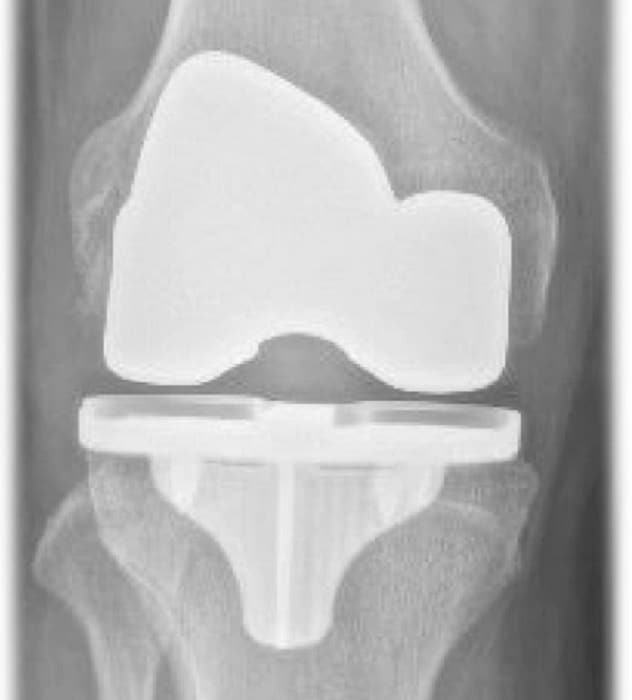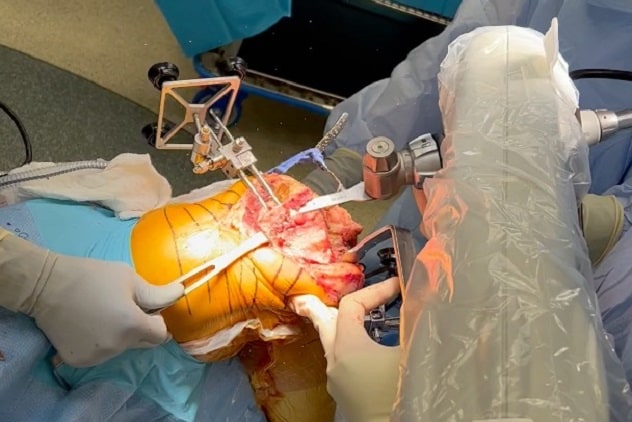Nov. 21, 2023
 Cementless fixation
Cementless fixation
While cement can wear out as time progresses, cementless fixation holds long-term.
According to Charles P. Hannon, M.D., M.B.A., an orthopedic surgeon at Mayo Clinic's campus in Minnesota, two developments in total knee arthroplasty (TKA) have revolutionized this surgery for orthopedic surgeons and their patients: cementless fixation and robotic surgery. Mayo Clinic is not only offering these technologies to patients who have TKAs but also investing in joint replacement technology innovation to continue to improve what is available for patients.
Cementless fixation
Cement has been the TKA fixation gold standard for decades. As the volume of knee replacements has grown, however — especially for younger, active patients — orthopedic surgeons have sought a different type of fixation that would hold long-term. Cement has the potential to wear out as time progresses.
Improvements in metals over time paved the way for cementless fixation, a technique in which the surgeon press-fits a prosthetic into the bone, allowing the bone to grow into the implant.
Dr. Hannon says patients have increasingly requested cementless TKA, especially in certain U.S. locations where this technique is a focus. Along with asking for cementless TKA, he says, patients want surgeons who focus on this type of TKA fixation and who are experienced in performing this procedure manually or with robotics.
Physicians and their patients should be aware that there is still much to be learned about cementless fixation in TKA, according to Dr. Hannon. Thus, they should carefully seek out an orthopedic surgeon with expertise in the surgical technique and indications. At Mayo Clinic, all surgeons are fellowship trained, which is the group of orthopedic surgeons most adept at cementless TKA, he says. Training is crucial, according to Dr. Hannon, who notes that there are nuanced differences between the cementless press-fit technique and the cemented technique.
"A cementless TKA requires increased accuracy with technique and relies on perfect cuts every time," says Dr. Hannon.
Robotic surgery
 TKA robotic surgery
TKA robotic surgery
Robotic surgery for total knee arthroplasty
Robotics also have moved the TKA field forward. The adoption of robotic surgery in knee replacement has grown alongside robotics' growth in multiple other medical fields.
The goal of robotics in TKA is improved accuracy and precision, which are crucial for an optimal result, says Dr. Hannon. He explains that robotic TKA is more consistent than manual TKA. This is because with a robot, there are no human issues such as a hand shifting. The robot provides real-time, intraoperative quantitative feedback to perfectly position an implant. Dr. Hannon notes that such technological tools are not intended to replace TKA surgeons but rather to enhance their work.
"Robotics are really a tool to minimize technical errors and optimize function in the OR," he says. "You can dial in the angle and depth of your cuts within one-half millimeter."
Dr. Hannon cautions, however, that not all robotic systems are the same. He notes that it is important for the surgeon to know the unique strengths and limitations of the specific robotic system the surgeon is using.
Mayo Clinic's joint replacement technology program
Technology in joint replacement is a major area of both clinical and research interest in Orthopedic Surgery at Mayo Clinic. Dr. Hannon is leading efforts to create a joint replacement technology program. The institution is also leading innovation in these areas, he says.
"Mayo Clinic has an undisputed amount of expertise in joint replacement technology and is leading innovation in this area."
As part of this program, Dr. Hannon and his research colleagues are studying robotics, cementless technology and clinical outcomes. He envisions that robotics will continue to make a difference in knee surgery, such as with repair of varus deformity, also called bowleggedness. He also says his team is exploring the use of robotics for TKA revision joint replacements.
Dr. Hannon's team also is researching remote monitoring post-surgically for patients who have TKA. This would allow orthopedic surgeons to get real-time data in the OR from the robot and then from the monitoring system when the patient goes home. This allows the team to correlate the impact of decisions made intraoperatively with the robot with clinical outcomes after surgery.
Referral considerations
Referring patients to Mayo Clinic for TKA gives them access to the latest joint replacement technology and to surgeons with significant expertise in its use, says Dr. Hannon.
Mayo Clinic staff values communication with referring physicians and provides regular updates, viewing the patient's care as a partnership. The institution follows patients who have TKAs for a lifetime, making Mayo Clinic referring physicians orthopedic partners for the life of all such patients.
"Mayo Clinic has an amazing registry that has long-term follow-up no one else has," says Dr. Hannon.
He notes that Mayo Clinic has developed many orthopedic technology tools, with advances continuing and helping to evolve the practice.
"Mayo Clinic has an undisputed amount of expertise in joint replacement technology and is leading innovation in this area," he says.
For more information
Refer a patient to Mayo Clinic.